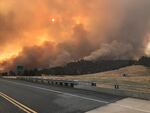Oregonians will have the chance to weigh in on proposed new smoke management rules that could ease the way for more controlled burns aimed at reducing the threat of major wildfires.
State regulators will hold public hearings in five cities often affected by smoke from wildfires.
Under the proposals, there would no longer be a strict ban against allowing controlled burns projected to cause visible smoke in nearby communities. Instead, these prescribed fires would have to remain under certain state and federal clean-air standards.
“We believe that will give us increased flexibility for using prescribed fire while still protecting communities,” said State Forester Peter Daugherty, who heads the Oregon Department of Forestry.
Related: Efforts To Reduce Wildfire Risk Fall Short, Buck Science
That agency is working with the Department of Environmental Quality on a rewrite of the rules governing prescribed fires, which are often used to reduce grasses and other underbrush in forests particularly prone to wildfires.
There has been increased interest in using fire as a tool to help reduce the number and magnitude of wildfires. More than a century of fire suppression is a big factor in creating more densely stocked forests, which are now even more prone to burn in the drier, hotter conditions brought on by climate change.
Daugherty said in some cases, the new standards could be breached for one-hour periods in communities particularly vulnerable to wildfire if they develop programs to protect vulnerable populations. This includes such steps as providing community warnings of prescribed fires and indoor locations providing filtered air.
Carrie Nyssen, senior director of advocacy for the American Lung Association in Oregon, served on the advisory committee that developed the rules. She said she understands the need to use fire as a tool to reduce fuel loads in the forest, but she said her organization couldn’t support the new rules.
“I don’t think the Lung Association could ever get to a place where we support prescribed burning,” she said, calling it a “tough issue” with “no perfect path.”
Related: Breathing Wildfire Smoke Every Summer Could Have Long-Term Consequences
Nyssen said the Lung Association wants to ensure that there is good community notice about the dangers of smoke, and that particularly vulnerable groups — like kids in daycare and seniors in long-term care — are in buildings with air filters.
Mark Stern, Oregon forest conservation director for the Nature Conservancy, was among those pushing for more flexibility in the rules.
“I think the idea that we can have zero tolerance to smoke of prescribed fire … is just a little out of kilter,” Stern said, “given that we’re in an era where we’re facing more wildland fires” producing extremely unhealthy levels of smoke.
Stern noted that most controlled burns are conducted in spring and fall, when the weather is cooler, and the fires burn less intensely than during the height of fire season. He pointed to a chart showing air quality in Bend in 2017. The city’s air remained in the healthy zone during three nearby prescribed burns, but spiked into unhealthy levels when it was hit with smoke from wildfires in August and September.
Richard Whitman, director of the Department of Environmental Quality, said he is also concerned about degrading air quality.
The “devil in the detail here is how to do more prescribed burning,” he said, “but do it in a way that’s smart and that does not create unexpected problems in communities.”

The Klamathon Fire which started July 5, 2018, burns its way along the California-Oregon border.
InciWeb
Some fire experts have called for a several-fold increase in controlled burns, which now on average cover about 167,000 acres a year, according to the Department of Forestry.
Daugherty, the state forester, said he was unsure how much the practice might increase in Oregon if the rules are loosened. One indication, he said, is that there were applications to burn more than 200,000 acres a year but not all of that work cold be completed. Some of that, he said, is due to the strictness of Oregon’s smoke management rules.
Five public hearings will be held around Oregon, starting on Tuesday.
La Grande: 7 p.m. PT, Tuesday, Aug. 21, at the OSU Extension Service, 10507 N. McAlister Road.
Bend: 7 p.m. PT, Wednesday, Aug. 22, at the Deschutes Service Building, 1300 NW Wall St.
Klamath Falls: 7 p.m. PT, Thursday, Aug. 23, in the Mt. Thielsen Room at the Oregon Institute of Technology, 3201 Campus Drive.
Eugene: 7 p.m. PT, Tuesday, Aug. 28, at the Lane Regional Air Protection Agency, 165 E. 7th Ave., Suite 100.
Medford: 7 p.m. PT, Wednesday, Aug. 29, at the Smullin Health Education Center, 2825 E. Barnett Road.
Comments may also be submitted online and by mail. The comment period closes at 4 p.m. PT, Sept. 14.
The new rules need to be approved by both the state Board of Forestry and by the Environmental Quality Commission. Officials hope that they will be in use by the spring of 2019.